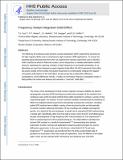Frequency-Swept Integrated Solid Effect
Author(s)
Walish, Joseph J.; Can, Thach V; Walish, Joseph John; Swager, Timothy M; Griffin, Robert Guy
Downloadnihms888542.pdf (1.116Mb)
OPEN_ACCESS_POLICY
Open Access Policy
Creative Commons Attribution-Noncommercial-Share Alike
Terms of use
Metadata
Show full item recordAbstract
The efficiency of continuous wave dynamic nuclear polarization (DNP) experiments decreases at the high magnetic fields used in contemporary high-resolution NMR applications. To recover the expected signal enhancements from DNP, we explored time domain experiments such as NOVEL which matches the electron Rabi frequency to the nuclear Larmor frequency to mediate polarization transfer. However, satisfying this matching condition at high frequencies is technically demanding. As an alternative we report here frequency-swept integrated solid effect (FS-ISE) experiments that allow low power sweeps of the exciting microwave frequencies to constructively integrate the negative and positive polarizations of the solid effect, thereby producing a polarization efficiency comparable to (±10 % difference) NOVEL. Finally, the microwave frequency modulation results in field profiles that exhibit new features that we coin the “stretched” solid effect.
Date issued
2017-06Department
Massachusetts Institute of Technology. Department of Chemistry; Francis Bitter Magnet Laboratory (Massachusetts Institute of Technology)Journal
Angewandte Chemie International Edition
Publisher
Wiley-Blackwell
Citation
Can, Thach V. et al. “Frequency-Swept Integrated Solid Effect.” Angewandte Chemie International Edition 56, 24 (May 2017): 6744–6748 © 2017 Wiley-VCH Verlag GmbH & Co. KGaA, Weinheim
Version: Author's final manuscript
ISSN
1433-7851
1521-3773